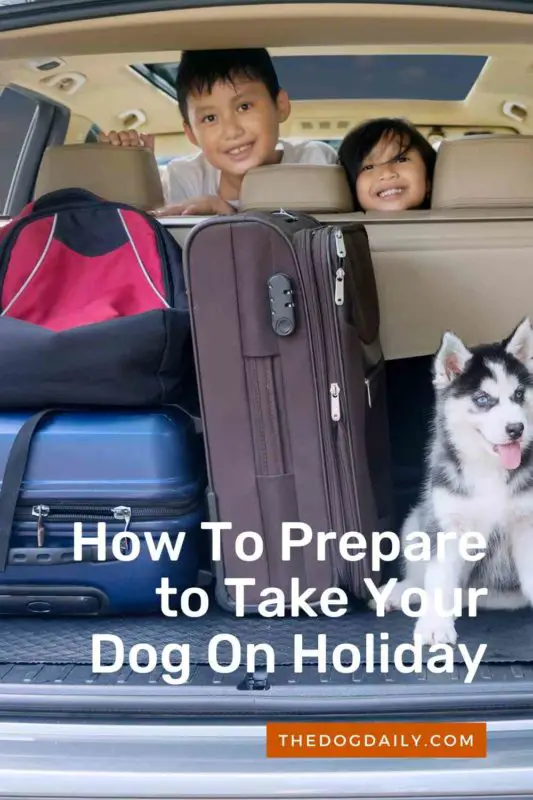Vacation Safely with Your Dog
Our dogs can make every day feel like a holiday, given their playfulness, puppy-at-heart good natures, and satisfaction with just being by our side. And if you typically go everywhere with your dog, it’s no wonder you want to take your dog on holiday with you.
Charlotte Reed, author of The Miss Fido Manners Complete Book of Dog Etiquette: The Definitive Guide to Manners for Pets and Their People, points out that not all dogs, or destinations, make such visits possible. Some people love dogs but don’t want them as visitors. Other friends and family members may suffer from pet allergies. And the reality may be that even though you love and understand your dog, your pet could be aggressive around others, not be properly housebroken, bark when lonely, or be a destructive chewer.
When Gerard Hanson of New York City planned a road trip to visit a friend in Maine, he was excited to bring his puppy, Charles, along. But the trip did not go smoothly. “Charles got carsick,” explains Hanson. “Then my friend didn’t want me leaving him at his house alone for more than an hour or two, so my plans for different activities were more or less ruined.”
Dr. Louise Murray, DVM, director of medicine for the ASPCA’s Bergh Memorial Animal Hospital in New York City, has heard stories like Hanson’s before. “Deciding to travel with a dog is a commitment. If making sacrifices on vacation doesn’t appeal to you, leave your pet at home,” she cautions. Below, Dr. Murray offers advice for those who decide that the company is worth the extra effort.
But assuming that your hosts are receptive to dogs and that your pet is well-behaved, here are our tips:
How To Prepare to Take Your Dog on Holiday
-
Talk With Your Host Ahead of Time About Your Dog
Address any potential problems, such as issues involving your host’s children and pets, furniture concerns, dog bathroom issues, etc.
-
Investigate Nearby Kennels and Pet Sitters Close to Your Host’s Home
Just in case things don’t work out as you planned and you need a plan B.
-
ID tag or Microchip for Your Dog
If your dog doesn’t have an ID tag or microchip already, it is now a good time to invest in both. The identification should provide two phone numbers where you can be contacted. Your pet’s name and address are far less critical but should also be included.
-
Try to Pack Enough Food to Last Your Dog Through the Entire Vacation.
“The digestive tract of dogs craves continuity,” says Dr. Murray. While vacation may mean new cuisines for you, new foods can leave your dog with diarrhea or an even more severe condition like pancreatitis, a sudden inflammation of the pancreas caused by eating fatty foods like table scraps. If it’s impossible to bring that much kibble, find a pet store at your destination that carries your dog’s typical fare.
-
Be Prepared to Manage Chronic Health Problems
For dogs with chronic health problems, prepare for flare-ups on the road. Pack enough medication and put it in two different places. “You don’t want a stolen car to get in the way of your pet getting much-needed medicine,” cautions Dr. Murray. Bring a copy of your dog’s medical records as well. “If there’s an emergency, you don’t want to be in the ER saying, ‘He takes this little pink pill.'”
-
Brush Up on Your Dog’s Obedience Skills
Most trips, especially those made during the holidays, are planned months ahead of time. When you begin planning your trip, make sure you also spend time brushing up on your dog’s obedience skills. Ensure your dog will walk nicely on the leash, stay when you ask him to, and come when you call him. Teach him to sit when people greet him instead of jumping up on them.
You may not mind if your dog is rowdy and bouncy, but if you ever want to be invited back (with your dog), the chances are much better if your dog is well behaved.
What Do I Need To Bring for My Dog on Holiday?
You’ll need to bring your travel supplies with you, even if you visit someone who also has dogs. Here is a list of essentials for taking your dog on holiday:
- Collar: Make sure your dog is wearing a buckle collar with his identification tag on it.
- Leash: Have a four- or six-foot leash for walks and supervision at your host’s house, and a longer leash so your dog can get some exercise during your travels.
- Crate: If your dog doesn’t already have his crate, make sure you buy one and introduce it before your trip.
- Bedding: Bring your dog’s usual bed or blankets, or if that isn’t practical, bring a sheet or blanket for them to sleep on.
- Food and Water Bowls: Carry bowls with you. Don’t expect to use your host’s kitchen bowls.
- Plastic Placemat: to put under your dog’s bowls to protect your host’s floor from any spills.
- Food: Bring a supply of your dog’s regular food.
- Treats: A right amount of treats will help encourage your dog’s training skills and best behavior.
- Toys: Bring a couple of your dog’s favorite toys and a few chew toys to keep him occupied.
- Grooming Tools: Depending upon your dog’s coat length and type, you may need to bring a brush, comb, towel, and clean-up wipes.
- What else? I also carry a canine first aid kit, including Benadryl (in case of bites, stings, or allergic reactions) and Pepto Bismol (in case of digestive upsets). Odor eliminator and a stain-removal product – just in case.
Once you have traveled a few times with your dog, you may find other supplies to make your trip easier.
Can I Take My Dog on a Plane?
If air travel is in your plans, Dr. Murray warns against taking big dogs on planes, where they must ride underneath the cabin. “Your dog should ride with you in the cabin or stay home unless you’re going away for far too long to consider that option.” She also advises against sedating animals during air travel, as sedatives leave them unable to regulate their temperature, blood pressure, and heart rate, putting them at risk for immediate health problems. For more information about taking your dog with you on a plane, see our article ‘The Essential Guide To Taking Your Dog on Holiday With You.’
At Your Holiday Destination with Your Dog
Whether it’s a dog-friendly hotel or a dog-friendly relative who will be housing you during your vacation, your pet must leave a good impression. “Encourage the trend of dog-friendly hotels by making sure your dog is a good ambassador. Don’t allow it to chew the furniture or sniff other guests in the lobby,” says Dr. Murray.
Before your arrival, review hotel animal policies or talk to your hosts about their expectations.
Transition your pet to the new environment by unpacking and organizing the items you brought and creating a haven for your dog. Introduce your pet to any other animals in the household as soon as possible, closely monitoring their interactions
Ensure your pet’s emotional ease by bringing something from home that smells familiar, be it a pillowcase or a dog bed. A dog that feels safe and secure will most likely be an excellent travel companion. “Vacationing with a beloved dog can be rewarding for a pet lover,” says Dr. Murray. With these precautions mentioned above, it can also be a real treat for your best friend.
Pets find comfort in routine and still need your attention. Although you will be busy, balance your activities to do what you would typically do together at home. You might have to adjust feeding and walking times, but with a little extra work and planning, both you and your dog should enjoy a fun visit.
Supervising Your Dog on Holiday is Important
When you’re traveling, and you get to your destination, you must supervise your dog carefully. Keep your dog on a leash, even in the house, to prevent him from wandering and getting into trouble. Take him outside and show him where you would like him to relieve himself.
Close supervision (and a leash on your dog) will also keep your dog from getting lost. An open gate or door is an invitation for a dog to explore, and in a strange place, your dog won’t know where he is or how to get back home.
The Crate Is Great For Your Dog on Holiday!
When you cannot supervise your dog, put him in his crate. A crate, often called a kennel, or a kennel crate, is a traveler’s best friend. It provides your dog with his own space and a retreat during a trip. It prevents him from getting into trouble.
Once you arrive at your location, the crate can confine your dog when you can’t watch him or leave the house. He can also sleep in it at night, either at your host’s home or in your hotel. By confining your dog, you keep him safe and secure and prevent potential damage, including housetraining accidents.
If your dog doesn’t have a crate at home, you will want to introduce it before your trip, so he’s comfortable with it. See below, “Introducing a Crate.”
Be Considerate of Your Host
When visiting with your dog, consider your hosts (even if they are family!). After all, you’re staying (or visiting) in their home. If they prefer that dogs stay off the furniture, keep your dog off the furniture, even if he’s allowed on the couch at home. If your hosts prefer that dogs stay out of the kitchen, don’t let your dog wander in there. Again, your dog’s leash can help you enforce the new rules.
Don’t expect your hosts to supervise or care for your dog. Not only is the dog unsure of your hosts, but they also haven’t trained him. You must manage your dog and prevent him from causing trouble.
If your hosts have pets of their own, make sure your dog doesn’t harass them. After all, this is their dog’s home, too; your dog is the intruder. If your hosts have a dog, introduce the dogs somewhere away from their house – at a park or even just out on a walk. Don’t force the dogs to play or get along; just let them get to know each other. Then closely supervise their first interactions at your host’s home, just in case there is a problem. If your hosts have a cat, don’t allow your dog to chase the cat; it’s her house! Keep your dog on the leash or in the crate.
Introducing the Crate to Your Dog
- Choose a big enough crate for your dog to stand up, turn around, and comfortably lie down.
- At home, prop open the door to the crate and begin tossing treats inside it, one at a time, encouraging your dog to go inside for the treats.
- After a few days, your dog should be eager to dash in and get the treat. Then begin feeding your dog in the crate.
- Set his food bowl in the back of the crate. Keep the door open and let your dog go in and out as he wishes while eating. After several days of this routine, close the door after he’s gone in to eat. When he’s done eating, open the door and let him out.
After several days of eating in the crate, your dog should be comfortable with it; begin confining him for short periods. He can also start spending the night in his crate; just set it in your bedroom so he can be close enough to hear and smell you.
Article written by Author: Darcy Lockman, Liz Palika, and The Dog Daily Expert

